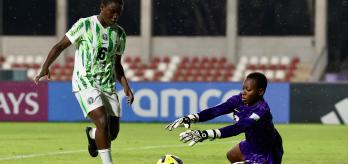With the knockout stages underway, FIFA’s Technical Study Group (TSG) and Football Performance Insights Team look back on all the footballing action to identify several emerging themes in the first 36 games and delve deeper into why these observations may be occurring. The themes discussed include goals from set plays, direct attacking transitions, defending 1v1s, and goal kicks from centre-backs.
Overview
-
The TSG have observed teams playing direct during attacking transitions, looking to exploit the opposition before they have the chance to organise themselves.
-
More direct attacks are having knock-on effects on players out of possession, who find themselves defending more 1v1 situations as a result.
-
Set-play goals have featured heavily in the tournament group stage, with teams showing the critical ability to read the game in the moment.
- Centre-backs are assisting goalkeepers with goal kicks – an observation aligning with a broader tactical trend seen at the elite senior level.
Direct play in transition
TSG expert Clémentine Touré observed several teams transitioning into attack with speed and direct play.
“Historically, in past U-17 women’s competitions, many teams favoured a possession or progression style of play. Here, at the U-17 Women’s World Cup in Morocco, fewer teams are trying to build up play all the time, and more are willing to counter-attack and play quickly, which explains the high-block positioning. We can cite countries such as Brazil, France, Canada, Nigeria, Japan, Zambia and Morocco that were capable of transitioning quickly from defence to attack, and exploiting space in depth.
“Based on this observation, I can say this U-17 Women’s World Cup group stage marks a shift towards a more dynamic offensive-transition game. Fast and direct play, combined with verticality, remain key factors. It is a crucial moment to score or throw the opponent off balance,” adds Touré.
Touré explains the vital elements during these fast-paced moments of the game.
“Although the attacking transition is used to the advantage of many teams, there are still growth opportunities. It is not only necessary to initiate the transition well, but also to finish it well. The moment of transition is always critical: recovery followed by quick execution. If the first pass is slow or poorly chosen, the advantage is lost. The observation is that, in this U-17 category, consistency is a key focus area.
“In conclusion, we can say that attacking transitions have become fundamental in modern football because they exploit the moments when the opponent is most vulnerable, just after losing the ball. Their defensive structure is often not yet in place, and players are scattered, sometimes in attack, which creates free spaces to exploit. Modern teams focus on efficiency, fewer passes and more impact,” adds the former Côte d’Ivoire women’s head coach.
Defending 1v1 situations
Earlier in the tournament, after several standout performances from wingers, TSG member Asako Takakura discussed the various phases of a winger’s 1v1 duels when attacking in wide areas. That said, the group stage has also offered some strong examples of defending in these situations, too. Takakura explains how other emerging themes in the tournament, like the direct transitions highlighted by Touré, are influencing this.
“Many teams aim for direct play, seeking to send the ball forward as quickly as possible. In this context, both centre-backs and full-backs face the crucial task of coping with one-on-one speed. Positioning off the ball is also vital, though its precision varied between teams and individuals,” explains Takakura.
“There is a general tendency for teams to favour high pressing. In such situations, player-to-player marking often becomes the norm, making it extremely important for non-defenders to maintain solid defensive positioning to avoid being beaten. Defensive awareness and continuity have improved compared to before.”
Accuracy and variety in set plays
One of the standout themes from the group stage in Rabat was the quality some teams showed from set plays. Teams scored a total of 44 goals from dead-ball situations, which accounts for 33.8% of all goals scored in the competition to date.
For TSG member Mo Marley, players’ intuitions are a significant factor in this. “What impresses most is the recognition from the players ‘living in the moment’ for them to see a window of opportunity and what’s possible right now. You can practise set plays regularly, but you can’t account for how the opposition will set up or how they will respond. It’s brilliant to see players assessing and making the decision based on what they are seeing.”
“At the later stages of elite competition, the game can be very evenly balanced – set plays are an ideal way to put immediate pressure on the opponent’s goal. When a team has a variety of pre-determined moves and technical ability to deliver consistently in high-pressure moments, it really can be a game changer.”
Even from the group-stage matches she has observed, Marley highlights three examples of goals scored from corners at pivotal moments of a game.
China benefitted from their set-play prowess during the group stage, scoring six goals from dead-ball situations in total. The Asian side impressively scored a direct free kick in each of their three group-stage matches. The variation in their set-piece takers was noteworthy, adds Marley.
“The three goals scored by a direct free kick from outside the box were taken by two different players with different dominant feet: Zeng Yijie (17) scored two with her right, and Chen Ruilin (6) scored one with her left. China also added variation with goals scored from a short corner, and had the option for a longer delivery.”
Other countries have also displayed variety, notes Marley.
“Canada scored from two corners by being proactive in the six-yard box [goal area] versus Samoa and France. Spain have also shown they have variety with free kicks and corners, with short options or more direct deliveries, both in-swinging and out-swinging. They also scored a direct free kick against Côte d’Ivoire.
“The modern game is advancing, and teams are becoming more unpredictable, and greater attention and dedicated practice time to attacking set plays is evident. Whilst it’s great to see creativity and attacking set plays scored, we need to ensure defending set plays develops at the same rate.”
Goal kicks from centre-backs
One new observation at the group stages of the tournament in Morocco is the number of centre-backs taking goal kicks. For Pascal Zuberbühler, TSG Lead and Senior Goalkeeping Expert, this is partly related to a broader tactical shift currently seen at all elite levels of the game, where having a centre-back take a short goal kick gifts the goalkeeper two or three vital seconds more to make a decision before they receive the ball and play their pass.
“In this clip below, we see the centre-back take the goal kick, which means the pressure is not on the goalkeeper straight away. The goalkeeper then plays a good pass into the number 9, who retains the ball. Then, Italy find themselves in a promising 3v3 situation, which they end with a fantastic finish,” adds Zuberbühler.
“For these types of goal kicks,” explains Zubi, “you need to have a goalkeeper with an overview. When do I play long? When do I play short? Can I play a ball through? And this is always done with risk, because, as we see in the clip above, the opponents press high.” It’s the range of distribution a goalkeeper possesses which helps make them top performers in these situations.











